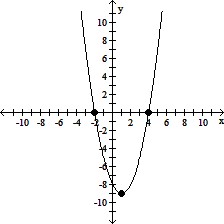Provide an appropriate response.Finish the statement with a correct response. To divide two fractions one needs to:
A. Use the reciprocal of the second fraction (divisor), add the numerators and multiply the denominators.
B. Use the reciprocal of the second fraction (divisor) and multiply.
C. Add the numerators and multiply the denominators.
D. Add the numerators and factor the denominators.
Answer: B
You might also like to view...
Use mathematical induction to prove that the statement is true for every positive integer n.2n > 2n + 2, for n ? 4
What will be an ideal response?
Find the domain, the range, and any intercepts.
A. domain: (-?, ?); range: (-9, ?); intercepts: (0, -8), (-2, 0), (4, 0) B. domain: (-?, ?); range: [-9, ?); intercepts: (-8, 0), (0, -2), (0, 4) C. domain: (-?, ?); range: [-9, ?); intercepts: (0, -8), (-2, 0), (4, 0) D. domain: [-9, ?); range: (-?, ?); intercepts: (0, -8), (-2, 0), (4, 0)
Use Descartes' Rule of Signs and the Rational Zeros Theorem to find all the real zeros of the polynomial function. Use the zeros to factor f over the real numbers. f(x) = 3x3 + 8x2 - 5x + 6
A. -3,  , 1; f(x) = (3x - 2)(x - 1)(x + 3)
, 1; f(x) = (3x - 2)(x - 1)(x + 3)
B. 1,  , -3; f(x) = (3x - 2)(x - 1)(x + 3)
, -3; f(x) = (3x - 2)(x - 1)(x + 3)
C. -1,  , -3; f(x) = (3x - 2)(x - 3)(x + 1)
, -3; f(x) = (3x - 2)(x - 3)(x + 1)
D. -1,  , 3; f(x) = (3x - 2)(x - 3)(x + 1)
, 3; f(x) = (3x - 2)(x - 3)(x + 1)
Factor the trinomial completely. If the polynomial cannot be factored, write "prime."x6 + 9x5 + 8x4
A. x4(x - 1)(x + 8) B. x1(x2 + 9x + 8) C. x4(x + 1)(x + 8) D. x4(x + 1)(x - 8)